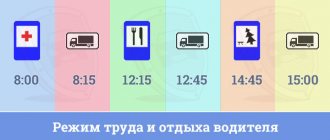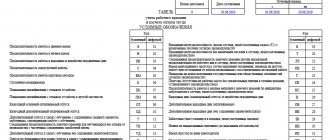Article 100. Working hours
The working time regime should provide for the length of the working week (five-day with two days off, six-day with one day off, a working week with days off on a sliding schedule, part-time work), work with irregular working hours for certain categories of workers, the duration of daily work ( shifts), including part-time working days (shifts), start and end times of work, time of breaks in work, number of shifts per day, alternation of working and non-working days, which are established by internal labor regulations in accordance with labor legislation and other regulatory legal acts containing labor law norms, collective agreements, agreements, and for employees whose working hours differ from the general rules established by a given employer - an employment contract.
(as amended by Federal Law No. 90-FZ of June 30, 2006)
Features of the working hours and rest time for transport, communications and other workers with a special nature of work are determined in the manner established by the Government of the Russian Federation.
How and by what documents the labor regime is determined
The work schedule for each individual employee must be discussed with him in advance - when concluding an employment agreement. In general, according to the organization in the context of structural divisions or positions, the working hours are determined in the internal labor regulations.
PVTR is a local regulatory legal act of an organization that defines the main points of the relationship between a team of employees and the employer - rules for hiring and terminating labor relations, powers and obligations of the parties to an employment agreement in the process of work, general conditions regarding the working time regime, etc. PVTR are approved by the employer in agreement with the trade union organization, each employee must be familiarized with this document in writing when concluding an employment contract.
In the PVTR, the working time regime of an organization can be reflected by:
- establishing the duration of the work week and specific daily work time frames for certain groups of positions (for example, “For departments: Management, Human Resources Department, Legal Service, Accounting, Office - a five-day work week, the beginning of the working day is 8:00, the end of the working day day - 17:00, break for rest and food - from 13:00 to 14:00");
- establishing for certain positions the condition of an irregular working day, indicating the amount of compensation in the form of additional days (at least three) of vacation in accordance with Art. 119 of the Labor Code of the Russian Federation (for example, “For positions: Director, Deputy Director, driver - an irregular working day is established with compensation in the form of 4 days of additional vacation period annually”);
- establishing a work schedule for individual departments and positions (for example, “For the sales department, a work schedule is established in compliance with labor standards for a five-day, 40-hour work week”);
- establishing a summarized accounting of working time for individual positions (for example, “For the position “Seller”, a summarized accounting of working time is established, the accounting period is a quarter”);
- establishing a flexible work schedule, night (equated to daytime) work schedule, shift schedule, dividing the working day into parts for certain categories of workers (for example, “For the position “Cashier”, a shift work schedule is established, in which the third shift, falling at night, is equivalent to to daytime working hours").
The employment agreement must contain a section dedicated to the working regime. For employees whose position involves working a regular schedule of five or six days a week, the agreement specifies the exact work schedule. For those who will work according to a schedule, with cumulative accounting, with irregular working hours, with part-time working hours, with the day divided into parts, etc., these circumstances must be reflected in the specified agreement. Cases of establishing an unspecified working time regime are illegal; such a violation may entail liability for the employer under Art. 5.27 of the Code of Administrative Offenses of the Russian Federation with all the ensuing consequences (fines and other sanctions).
A section on working hours must be included in the contract
How to establish new regime rules in an organization: procedure and documents
If an employee becomes familiar with the existing regime for a particular position when being hired by signing an employment agreement and marking the reading of the PVTR, then changing the current regime is somewhat more complicated.
The decision to change the PVTR can be issued in the form of an order
The procedure is as follows:
- To begin with, the manager must make an informed decision about for which positions or structural units new rules are being introduced.
- Then, in accordance with all the rules for changing the local regulatory legal acts, the corresponding changes are made to the PVTR (the project must be agreed upon with the trade union within five days, then signed by the manager).
- Based on the amended PVTR, each employee affected by the changes is warned of changes in essential working conditions (notice must be handed in against signature no later than a month before the order is issued). In case of refusal to continue the employment relationship under the changed conditions, the employee must be dismissed upon expiration of the notice period.
- Within the prescribed period (a month after notifying employees), an order is issued for the enterprise to change the regime for specific employees (at this stage they must be listed by name). Each employee gets acquainted with the order by signing it.
- On the day the administrative document is issued, an additional agreement to the contract is concluded with each employee, changing the terms of the working time regime.
- From the date specified in the additional agreement and order, a new regime begins to operate with its new documentation (for example, with the drawing up of schedules).
Article 101. Irregular working hours
Irregular working hours are a special work regime, according to which individual employees may, by order of the employer, if necessary, be occasionally involved in the performance of their labor functions outside the established working hours. The list of positions of employees with irregular working hours is established by a collective agreement, agreements or local regulations adopted taking into account the opinion of the representative body of employees.
(as amended by Federal Law No. 90-FZ of June 30, 2006)
Can an employer force an employee to work overtime?
Employers often abuse their rights and, in fact, the working day can go far beyond the employee’s working hours. Indeed, labor legislation contains a list of situations when an employee can be called upon to work overtime without his consent. But this applies to emergency situations, such as disaster prevention, during a state of emergency or martial law and, accordingly, to perform work in these situations.
In other cases, engaging an employee overtime is permitted only with his consent.
Article 103. Shift work
Shift work - work in two, three or four shifts - is introduced in cases where the duration of the production process exceeds the permissible duration of daily work, as well as in order to more efficiently use equipment, increase the volume of products or services provided.
When working in shifts, each group of workers must work within the established working hours in accordance with the shift schedule.
When drawing up shift schedules, the employer takes into account the opinion of the representative body of employees in the manner established by Article 372 of this Code for the adoption of local regulations. Shift schedules are usually an annex to the collective agreement.
(as amended by Federal Law No. 90-FZ of June 30, 2006)
Shift schedules are brought to the attention of employees no later than one month before they come into effect.
Working two shifts in a row is prohibited.
Work schedule as a document regulating daily individual work schedule
The work schedule is one of the most important documents for organizing the work of those employees who do not work according to the general (production) calendar. Thus, the daily schedule regulates the time of coming to work, leaving work, break times, and even the workplace assigned to the employee.
The schedule is usually drawn up for one month, but this period is not regulated by law. Therefore, depending on the circumstances and characteristics of the production process, the document can be drawn up for a week, a quarter, or a year.
The schedule, as a document, can be drawn up:
- simultaneously for all employees of the enterprise;
- for employees of one structural unit;
- for a certain group of employees from different structural divisions;
- separately for one employee.
Form and symbols
In the shift schedule it is enough to indicate only the shift designation
looks like a table, each row of which is assigned to an individual employee, and the columns correspond to the calendar days of the period chosen to determine the work regime (for example, a calendar month).
The legislation does not oblige employers to use any standard unified form or adhere to any unified system of symbols when drawing up a work schedule. This means that each employer has the right to develop its own rules for drawing up this document, taking into account the specifics of the work of its organization, guided by the maximum ease of using the schedule in work.
You can include any information in the schedule:
- in the shift schedule, when the direct work schedule of the shift is already fixed in some legal regulation (for example, in the PVTR), it is convenient to include only an indication of the shift number for the employee on a specific day;
- a sliding schedule will inevitably have to include all possible elements of working time - the start and end time of the working day, the time of breaks, the total number of hours of work per day, information about the assigned place of work (if necessary).
Since any schedule is an employee’s work plan in accordance, first of all, with his individual work standard for the accounting period (month, quarter, etc.), the final column of the document always displays the amount of planned hours. If a month is selected as the accounting period, the resulting column will be one - the monthly norm. If the accounting period is a quarter, it is recommended to include two columns in the form - the monthly rate and the quarterly rate (the latter will be displayed “with a cumulative total” throughout the entire quarter).
When summarizing accounting, the schedule must contain columns reflecting the amount of hours per month, per quarter (depending on the accounting period)
The process of drawing up and approving the schedule
The procedure for drawing up and approving a schedule in an organization can be regulated either by a local regulatory legal act or by order of the manager. Persons responsible for maintaining, approving and approving documents are determined by designation in these documents and the inclusion of a corresponding item in the job description.
As a rule, the schedule is drawn up by the person responsible for this in the structural unit (department, service), endorsed by the head of the structural unit, a representative of the personnel department and the trade union, approved by the head of the enterprise or his deputy in charge of the relevant area of activity.
The schedule can be drawn up either manually (using standard Office tools with output on paper) or in specialized software packages (for example, 1C: HR and Salary, SAP, etc.).
Schedule requirements
When drawing up a work schedule, the employer is in a situation where it is necessary to comply with a lot of rules, requirements and interests. First of all, these are the requirements of labor legislation that protects the rights, interests and even health of the employee:
- The duration of daily work should not exceed those established by Art. 94 of the Labor Code of the Russian Federation limits (special limits are established for minor employees, disabled people, workers in harmful unsafe conditions).
- The number of working hours per week should not exceed the norm according to the production calendar (40 hours as a general rule). For those who have been assigned summarized accounting for an accounting period, it is mandatory to comply with the standard hours for this accounting period (quarter, month, etc.).
- Shifts that primarily occur at night should be reduced by 1 hour.
- After a shift lasting more than 24 hours, an equal or greater rest period is provided.
- If the employee does not have a condition for dividing the working day into parts, his lunch break (or the sum of several during the day) should not last more than two hours.
- The minimum lunch break is 30 minutes. It is obligatory to establish daily, if the agreement of the parties and the PVTR does not provide for the employee to eat food in parallel with work. Lunch break is not paid.
- It is prohibited to work during two shifts following one another.
- Hours that fall during an employee's illness or vacation are also included in his monthly (quarterly) rate. In other words, the employee is not required to make up the hours actually missed to normal.
- The limits established by Art. 99 of the Labor Code of the Russian Federation for overtime work (no more than four hours in a two-day working period, no more than one hundred and twenty hours per year), etc.
Of course, when creating a schedule, the operating mode of the enterprise, workload standards, and the interests of the employee himself are taken into account.
Employee familiarization
The employer is obliged to familiarize employees with the work schedule no later than one month before the day it comes into effect - this is a direct requirement of Art. 103 Labor Code of the Russian Federation. Violation of this deadline may result in administrative liability.
To avoid violating the requirements of the law, you should start drawing up a schedule no later than one and a half months before the start of the accounting period. For example, the schedule for December should be drawn up before October 15 in order to have time to coordinate, approve and familiarize all employees with it (after all, some of them at the time of familiarization may be on vacation or on sick leave, but this circumstance is not an excuse in case of violation of the deadlines for familiarization ).
Article 104. Summarized recording of working time
When, due to the conditions of production (work) of an individual entrepreneur, in an organization as a whole, or when performing certain types of work, the daily or weekly working hours established for a given category of workers cannot be observed, it is permissible to introduce summarized recording of working hours so that the working hours for the accounting period (month, quarter and other periods) did not exceed the normal number of working hours. The accounting period cannot exceed one year.
(as amended by Federal Law No. 90-FZ of June 30, 2006)
The normal number of working hours for the accounting period is determined based on the weekly working hours established for this category of workers. For employees working part-time (shift) and (or) part-time week, the normal number of working hours for the accounting period is reduced accordingly.
(Part two as amended by Federal Law No. 90-FZ of June 30, 2006)
The procedure for introducing summarized recording of working time is established by the internal labor regulations.
(Part three introduced by Federal Law No. 90-FZ of June 30, 2006)
Legislation
As mentioned above, there are several types of work schedules that are established in accordance with the Labor Code.
The concept of working hours is discussed in Article 100 of the Labor Code.
It concerns, first of all, the length of the week. Workers can work five or six days. Weekends may also be provided on a staggered schedule. And in some cases, an incomplete week is established. In addition, the article determines how many hours per day employees can be engaged in their work duties.
- Work on an irregular schedule is established in accordance with Article 101 of the Labor Code. This is a special mode of labor activity, when individual workers are occasionally involved in work, regardless of the main work schedule.
- A flexible work schedule is established in accordance with Article 102 of the Labor Code. Such work activity involves a shift or a day, the duration of which is determined by agreement (agreement) of the interested parties.
- Work on a shift schedule is established in accordance with Article 103 of the Labor Code. This working mode is necessary in cases where the main production activity does not fit into a standard eight-hour working day. For example, an employer cannot stop blast furnaces or any other production cycle.
Accounting for time worked (its summation) is carried out on the basis of Article 104 of the Labor Code. For example, the maximum weekly employment should not exceed 40 hours. The accounting period for a separate legal entity cannot exceed one year. And for workers engaged in hazardous or hazardous work, records are kept in three-month cycles.
Also, according to Article 105 of the Labor Code, it is allowed to divide the working day (shift) into parts, if such division does not disrupt production processes.
This division is carried out upon coordination of the schedule with trade union bodies, and is displayed in local documents.
Article 105. Division of the working day into parts
In those jobs where this is necessary due to the special nature of the work, as well as when performing work the intensity of which is not the same throughout the working day (shift), the working day can be divided into parts so that the total duration of working time does not exceed the established duration of daily work . Such division is made by the employer on the basis of a local regulatory act adopted taking into account the opinion of the elected body of the primary trade union organization.
(as amended by Federal Law No. 90-FZ of June 30, 2006)
Legislative regulation, mandatory conditions
The shift schedule is regulated by law, namely Art. 372 of the Labor Code of the Russian Federation (Part 3 of Article 103 of the Labor Code of the Russian Federation). When introducing it into an organization, it is required to strictly comply with the norms and conditions of the above section of the Labor Code of the Russian Federation.
The rules for operating in this mode are spelled out here quite thoroughly and clearly. There is no point in listing them in this article, but some simply need to be emphasized:
- the weekly working hours in the sum of all shifts should not exceed forty hours;
- every shift people should be given a lunch break (its duration is determined individually - from 30 minutes to 2 hours);
- employees must be provided with uninterrupted rest for 42 hours every week;
- the employer is obliged to indicate to employees that it is inadmissible for them to perform their duties in two shifts in a row (except in emergency cases) - and strictly monitor this.
If an organization feels the need to use a shift schedule for different categories (positions) of employees, then for each of them the duration of the shift can be determined separately (such situations occur in transport companies - one work mode is used for drivers, another for dispatchers, and another for service personnel). third).
When creating a schedule, one more important point should be taken into account - if most of it falls at night, then the shift should automatically be reduced by an hour.
All other working conditions must also comply with the law, including in matters relating to the payment of wages, provision of sick leave, vacation, etc.
Some points regarding payment
The calculation of remuneration for a shift schedule is somewhat different from the standard one. The specificity here is that the number of working hours according to the regime established at the enterprise may differ from the norm established by law, both upward and downward (the so-called planned overtime or underwork).
To ensure that there are no errors in salary calculations, at the end of the accounting period, the following parameters should be reconciled: the number of working hours in accordance with the norm and their number, based on real indicators. If, when comparing, the second indicator is greater than the first, you will need to calculate and pay the employee extra for overtime.
If an employee’s shift falls on a day off, then it is paid as usual (this is justified by the peculiarities of the shift conditions). If he is forced to work on a holiday (state non-working days are specified in the Labor Code of the Russian Federation), then he must be paid at the appropriate standard rate, i.e. in double size.
Temporary standards enshrined in the Labor Code
The legislation regulates several time periods related to working time, for which certain standards are established.
- Work shift or day – daily work activity. The law does not clearly define its duration. It is allowed to divide it into parts. Limits have been set to limit this period:
- 2.5 hours – for schoolchildren or students under 16 years of age, studying and working at the same time;
- 3.5 hours – for the same category from 16 to 18 years old;
- 5 hours – for young workers under 16 years of age;
- 7 hours – until employees’ 18th birthday;
- 6 hours – for employees of hazardous industries with a week lasting 30 hours;
- 8 hours - for them, if the week is 36 hours;
- as indicated in the medical report - for disabled people.
- Work week - the most commonly accepted interval used for calculations. The basis is the duration of work from Monday to Sunday (with one or two days off). Art. 91 sets "normal" work week, which is 40 hours. Other weekly norms are also regulated:
- incomplete week - introduced by agreement between the parties, when payment is calculated in proportion to hours worked; such a schedule can be established for certain categories of employees (pregnant women, caring for children or disabled people, parents of children under 14 years old);
- shortened week - provided for by the Labor Code regulations and internal documentation, when the normal duration is reduced due to the specifics of the working population (minus 4 hours or more per week for workers in hazardous industries, as well as young workers under 18 years of age; up to minus 5 hours - for disabled people; minus 16 hours – for the first job of 14-16 year old employees).
- Accounting period – a time period chosen to take into account the number of working hours worked and correlate them with standards. This is a certain form of control, reflecting the measure of this category. In the accounting period, shortfalls or overtime are identified according to working hours. This gap is fixed in the company’s regulatory documents and can be:
- month;
- quarter;
- any other period not exceeding a year.
- Occupancy limit – the limit above which the employer does not have the right to work an employee. Sometimes employees themselves express their desire (consent) to work beyond established standards (overtime) for appropriate pay. But the law does not allow this to be abused, for which the following limit standards are established:
- with a working day of 8 hours, overtime cannot exceed 4 hours;
- when working part-time, you cannot be employed for more than half the working day (except for days free at your main place);
- in any accounting period, it is prohibited to recycle more than 50% of the norm.
Consolidating the work order
If the management of an enterprise decides to use a shift work schedule, it must enshrine this norm in its accounting policies, or more precisely, in its Internal Regulations.
If the company has a trade union cell, these Rules, including those regarding shift work, must be approved by its representative. A five-day period is allotted for interaction with the trade union - during this period, trade unionists must either approve the Rules presented to them or challenge them with evidence.
It is also possible to establish the use of a shift schedule in a collective agreement.
In addition to the internal regulations and the collective agreement, the clause on shift work must be spelled out in sections of individual employment contracts with employees, indicating the number of hours per shift and other parameters.
Working hours for 2022: main differences from 2022
The working time schedule for 2022 is a multi-component document informing about the following:
- standard working hours;
- number of weekends and working days;
- boundaries and duration of the working day;
- combination of working periods with rest periods.
IMPORTANT! In 2022, those working the usual five-day workday will need to work 247 working days out of 365 calendar days. In 2020 there were 248 out of 366.
Comparing the annual chart of the period under review with the previous one, we can note the following:
- in 2022, the number of working and calendar days is 1 less, since the previous year was a leap year;
- Of the working days specified in the first paragraph, the opportunity to legally underwork 1 hour is allowed 4 times: February 20, April 30, June 11, November 3 (in 2022 this was possible 5 times: April 30, May 8, June 11, November 3 and 31 December);
- the number of weekends and holidays in 2022 will be 118 days (the same as in 2022).
See also the 2021 production calendar.
Results
A working time schedule is usually presented in tabular form and contains information about the beginning, duration and end of working hours, as well as rest periods.
Drawing up this document is not a legally established obligation of the employer, but it allows you to organize a continuous work process and not violate the norms of labor legislation.
You can find more complete information on the topic in ConsultantPlus. Free trial access to the system for 2 days.










